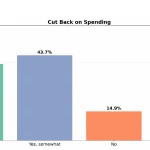If Dr. Benjamin Spock hadn’t been cremated, he’d be rolling over in his grave right now.
As many who were reared on the lefty pediatrician’s methods, or who perhaps have tried his best-selling book “Baby and Child Care,” will know, Spock was one of those who decried the spanking of children. According to The New York Times, in the 1985 edition of the book, he said that spanking taught “children that the larger, stronger person has the power to get his way whether or not he is in the right” and that the “American tradition of spanking” might cause violence.
“Indeed, most child-care experts today disapprove of physical punishment,” the Times reported in 1985.
“Dr. John F. Knutson, a professor of psychiatry at the University of Iowa, contends that spanking is ‘a seductively simple strategy for training children.’ Over the last six years, Dr. Knutson has surveyed 9,000 middle-class college students 18 to 20 years old. More than 80 percent reported that they had been spanked by their parents, 40 percent said they were struck with objects, including belts, switches and hairbrushes, and 10 percent described being injured by parents’ disciplinary actions.”
That accepted wisdom almost 40 years ago has become virtually ingrained in the American way of child-rearing: Any talk of spanking a child as a form of punishment, unless one is among like-minded parents, is met with recoil and disgust. We don’t know why; we just know that it’s violence against children, and it’s wrong. Right?
Well, according to The Science™, not necessarily.
According to the New York Post, a new study published in Marriage & Family Review earlier this month found that “spanking accounted for less than 1 percent of variations in child outcomes, showing that its negative effects might be exaggerated.”
The study was authored by Robert E. Larzelere, endowed professor of parenting research at Oklahoma State University. Larzelere, the Post reported, said “that spanking does not lead to negative consequences unless it is administered excessively or from a place of malice rather than genuine concern for the child.”
“I have been doing research for 40 years to try to answer two questions,” he told PsyPost.
“[One]: What disciplinary responses are more effective than spanking, so that we can recommend them to replace spanking? Answer so far: none, although parents should prefer milder and verbal disciplinary responses as much as possible.
“[Two]: Although it is clear that spanking is correlated with adverse outcomes such as delinquency, does it cause those outcomes (like smoking) or not (like hospitalization, which is also associated with worse outcomes compared to those never hospitalized)?
“Answer so far: Spanking does not cause harmful outcomes unless it is used too often or too severely or out of meanness rather than out of concern for the child’s welfare.”
Spanking, the study found, could only account for 0.64 percent of variances in externalizing issues. Even less of internalizing issues was attributable to the practice.
“In contrast, the slope method showed slightly more beneficial-looking effects. For instance, spanking was associated with a minor decrease in externalizing problems, but this effect was so small that it explained less than 0.1 percent of the variance,” PsyPost reported.
“This suggests that spanking has a minimal impact on externalizing problems, internalizing problems, cognitive performance, and social competence. The results indicate that previous reports of the harmful effects of spanking may have been overstated due to residual confounding — meaning other unmeasured factors may have influenced the negative outcomes rather than spanking itself.”
The most compelling evidence came from so-called “back-up spanking,” in which two open-handed swats are applied to the backside of a child who isn’t cooperating with time outs. This was found to be much more effective than allowing a child to come back from a time-out period with no consequences.
It’s worth noting that there is a narrow age band in which spanking is maximally effective, generally between ages 2 and 6. Between ages 8 and 11, spanking was found to lead to worse outcomes, albeit slightly so.
“Although different things work for different children (or for the same child at different times), spanking can be an effective disciplinary tool under some circumstances,” Larzelere said.
“The most effective way to use spanking is two open-handed swats to the bottom of 2- to 6-year-olds when they refuse to cooperate with milder disciplinary responses, such as time-out.
“When used that way, defiant children learn to cooperate with the milder disciplinary responses, so that spanking can be phased out. Similarly, timeout and privilege removal can be used to back up verbal explanations and negotiations, which should be preferred by all parents when appropriate.”
As PsyPost noted, this isn’t the first study to reach this finding about spanking, with a similar paper published in the journal Child Development in 2021 finding “occasional, mild spanking had minimal negative effects on child behavior.”
And, as Larzelere noted, studies had “rarely tried to distinguish between more and less effective ways to use spanking or other disciplinary techniques.”
“The studies of two-swat back-up spanking were done by one research clinic in the 1980s to try to find an effective alternative for back-up spanking,” Larzelere said. “They showed that a brief room isolation was just as effective on average, although they questioned whether rooms in homes would be as suitable for room isolation as in their clinic.”
“But hardly any conclusive research has been done since then. The failure to specify precise implementations and appropriate situations in research since 1990 may help explain why clinical treatments for oppositional defiance in young children are half as effective now as they were 30 to 50 years ago when psychotherapists trained parents to use spanking (or a brief room isolation) to enforce cooperation with time-out.”
Gosh, you don’t say.
This is what happens when you, pardon the pun, throw the baby out with the bathwater. Domestic abuse of any kind, child abuse included, is bad. Spanking is not child abuse; it’s a physical action that demonstrates to misbehaving children that actions have consequences when they cannot understand the very obvious relationship between the two in words. By teaching children this simple lesson, we show our love for them and make their lives less difficult further down the road.
Yet, we’ve been taught, for the better part of half-a-century, in some cases more, that spanking is abuse. Not only that, it leads to a peculiarly American kind of violence. This was liberal a priori thinking, which turned out to be very, very wrong. Will they admit as much? Of course not. When The Science™ doesn’t back them up, they merely bury it.
Advertise with The Western Journal and reach millions of highly engaged readers, while supporting our work. Advertise Today.







